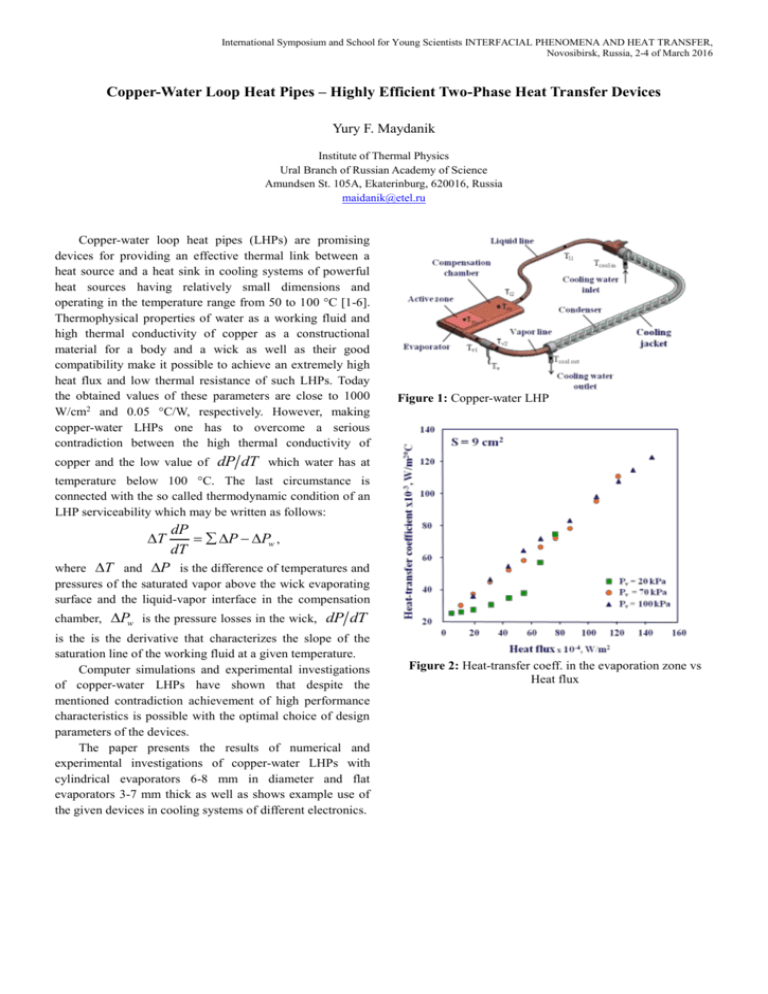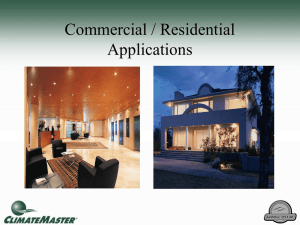Template for the Preparation of Abstract
advertisement

International Symposium and School for Young Scientists INTERFACIAL PHENOMENA AND HEAT TRANSFER, Novosibirsk, Russia, 2-4 of March 2016 Copper-Water Loop Heat Pipes – Highly Efficient Two-Phase Heat Transfer Devices Yury F. Maydanik Institute of Thermal Physics Ural Branch of Russian Academy of Science Amundsen St. 105A, Ekaterinburg, 620016, Russia maidanik@etel.ru Copper-water loop heat pipes (LHPs) are promising devices for providing an effective thermal link between a heat source and a heat sink in cooling systems of powerful heat sources having relatively small dimensions and operating in the temperature range from 50 to 100 °C [1-6]. Thermophysical properties of water as a working fluid and high thermal conductivity of copper as a constructional material for a body and a wick as well as their good compatibility make it possible to achieve an extremely high heat flux and low thermal resistance of such LHPs. Today the obtained values of these parameters are close to 1000 W/cm2 and 0.05 °C/W, respectively. However, making copper-water LHPs one has to overcome a serious contradiction between the high thermal conductivity of copper and the low value of Figure 1: Copper-water LHP dP dT which water has at temperature below 100 °C. The last circumstance is connected with the so called thermodynamic condition of an LHP serviceability which may be written as follows: T dP P Pw , dT where T and P is the difference of temperatures and pressures of the saturated vapor above the wick evaporating surface and the liquid-vapor interface in the compensation chamber, Pw is the pressure losses in the wick, dP dT is the is the derivative that characterizes the slope of the saturation line of the working fluid at a given temperature. Computer simulations and experimental investigations of copper-water LHPs have shown that despite the mentioned contradiction achievement of high performance characteristics is possible with the optimal choice of design parameters of the devices. The paper presents the results of numerical and experimental investigations of copper-water LHPs with cylindrical evaporators 6-8 mm in diameter and flat evaporators 3-7 mm thick as well as shows example use of the given devices in cooling systems of different electronics. Figure 2: Heat-transfer coeff. in the evaporation zone vs Heat flux International Symposium and School for Young Scientists INTERFACIAL PHENOMENA AND HEAT TRANSFER, Novosibirsk, Russia, 2-4 of March 2016 References Maydanik Yu.F., Miniature loop heat pipes, Keynote lecture, Proceedings of the 13th International Heat Pipe Conference, Shanghai, China, September 21-25, pp. 24-37 (2004) Maydanik Yu.F., Vershinin S.V., Development and investigation of copper-water loop heat pipes with high operating characteristics, Heat Pipe Science and Technology, Vol. 1 pp. 151-162 (2010) Maydanik Yu.F., Loop heat pipes – state-of-the-art and industrial application, Keynote lecture, Proceedings of the 9th International Heat Pipe Symposium, Kuala Lumpur, Malaysia, November 17-20, pp. 13-25 (2008) Becker S., Vershinin S.V., Sartre V., Laurien E., Bonjour J., Maydanik Yu.F., Steady state operation of a copper–water LHP with a flat-oval evaporator, Applied Thermal Engineering, Vol. 31 pp. 686–695 (2011) Maydanik Yu.F., Vershinin S.V., Chernysheva M.A., Yushakova S., Investigation of a compact copper–water loop heat pipe with a flat evaporator, Applied Thermal Engineering, Vol. 31 pp. 3533–3541 (2011) Maydanik Yu.F., Chernysheva M.A., Pastukhov V.G., Review: Loop heat pipes with flat evaporators, Applied Thermal Engineering, Vol. 67 pp. 294–307 (2014) Figure 3: Evolution of evaporating wick surface







